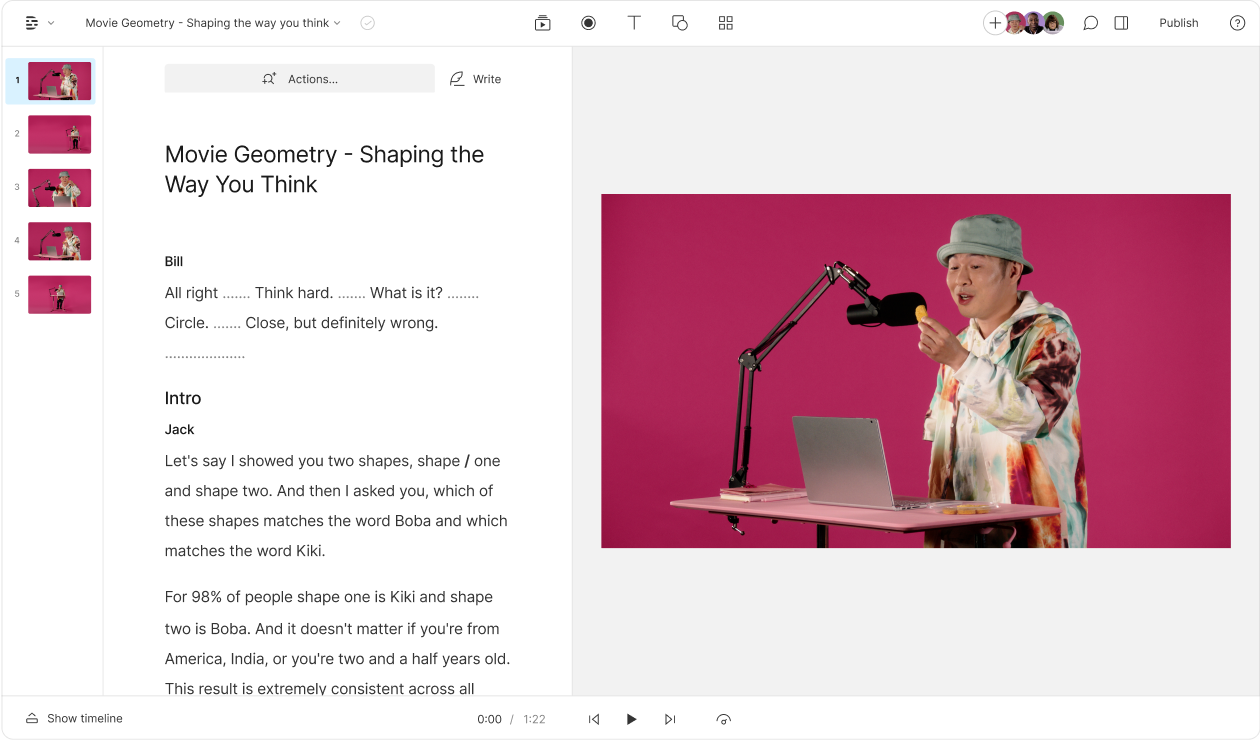What type of content do you primarily create?




Manually transcribing Zoom meetings sits in that special category of tasks we all avoid—like cleaning keyboard gunk or organizing digital photos. If you produce podcasts or content with Zoom interviews, you've probably faced the need to transcribe your interviews and wondered if there's a less painful way.
Here's the reality: you don't need to sacrifice your time or sanity. Modern transcription tools can convert your Zoom recordings into text with surprising accuracy, often in just minutes. In this guide, we'll walk you through three practical methods to transcribe Zoom meetings, with an honest assessment of which one delivers the best results for creators like you.
Can Zoom transcribe a meeting?
The short answer is yes; Zoom can transcribe your meetings for you. It can even provide automated captions (i.e., live captions) as you record in real time if you don't fancy waiting for a transcript afterward. This feature supports multiple languages, making it valuable for international teams and multilingual meetings.
There is, however, a catch. To enable transcription in Zoom, you'll need a Pro, Business, Education, or Enterprise license, and you specifically need to use cloud recording/storage (rather than local recording). We'll get into the details of how to transcribe Zoom meetings shortly, but it's worth mentioning that paid Zoom plans are required for the native transcription feature. The specific pricing may change, so check Zoom's website for current rates.
- Pro: $159.90/year/user (works out as $13.33 per month), or $15.99 monthly.
- Business: $2,199 annually (the business plan requires a minimum of 10 users, at a rate of $18.33 per month per user) or $21.99 /month/user (again, a minimum of 10 users)
- Education: this one likely isn't relevant for you (if you're a student, your institution may have a license), but here's the pricing page for education licenses.
- Enterprise: you'll need to contact the Zoom sales team.
As you can see, for most creators or small teams, it's better to go for a Pro subscription if you want more than what the free plan allows (which you'll need if you want native automatic transcriptions).
zoom’s expanded language support
Zoom’s AI Companion now supports up to 36 languages in meetings (in preview) and nine languages in Team Chat, including French, Spanish, and Japanese, to facilitate broader team collaboration. This expansion means you can toggle between different languages for real-time captions or post-meeting transcripts, though the exact availability might depend on your paid Zoom plan. If your account settings permit, Zoom can even auto-detect supported languages during a meeting and switch accordingly. These multilingual features are handy for global teams eager to overcome language barriers in their online calls. You can find more details about Zoom’s growing language coverage in Zoom’s official announcement.
How to transcribe Zoom meetings in 3 ways
Now we'll look at the practical elements of transcribing a Zoom interview in three different ways: using Zoom's native features, using Descript, and using an AI note-taker. Each method offers different levels of transcription accuracy and features. We'll include a step-by-step approach for each method and use screenshots where applicable.
How to transcribe Zoom meetings with the native feature
As mentioned above, you'll need a Zoom account that has cloud storage enabled for cloud-based video recording. Once you've signed up, you'll need to open the Zoom web portal and look for the right settings:
Step 1: Make sure you're signed in as the account admin, and in the navigation menu, click Account Management, then Account Settings, and click on the Recording tab.
 |
Step 2: Find the Zoom Cloud Recording setting and check to see if it's enabled; if a verification box appears, verify the change.
 |
Step 3: From there, you'll need to go to the Advanced cloud recording settings area, check the box that says "Create audio transcript" and click Save to get transcripts for your next recorded meetings.
 |
After you've completed these steps, you'll have a cloud-based folder with your video and audio-only recording(s), plus a separate VTT transcript file, which includes timestamps, in your list of recorded meetings — you also have the option to display the transcript on your recording like subtitles or closed captions (CC). Note that Zoom's native transcription doesn't automatically include capitalizations or punctuation, which may affect readability.
It's also worth noting that the above steps will also work if you're planning to use an iOS or Android device to record your meeting, providing cross-platform flexibility for mobile users who need to transcribe Zoom meetings on the go.
You can also edit the transcript of the video in Zoom (as long as you're in the Zoom web portal and in your Recordings list) because it doesn't automatically include capitalizations or punctuation.
How to transcribe Zoom meetings with Descript
There are two main methods of transcribing Zoom meetings with Descript; the first method uses the cloud recording link if you have cloud storage set up with Zoom (check out the above steps to set that up if you haven't). The second uses the local Zoom recording. Descript's transcription offers higher accuracy with proper punctuation and capitalization compared to Zoom's native option.
Cloud Zoom recording:
For the first method, make sure you choose the option to record to the cloud (it's the option under local recording).
After you've recorded your meeting, you can go to the Meetings tab in the app and click on the Recorded tab, then navigate to the meeting you recorded, which will show you the cloud recording link:
 |
Copy this link, and open Descript. From there, follow these steps:
Step 1: Open an existing project or create a new one, and open the Media Library at the top of the editor.
Step 2: From there, click on the ellipsis button in the bottom right corner and choose File from link (note: this is currently only possible on the app, not the web version of Descript).
 |
Step 3: After importing the recording file, you should see it appear in the files of your Media Library, and you'll be able to add it to your project.
Step 4: Once you've added the Zoom meeting to your project, Descript will automatically transcribe the video and add the transcription to your script.
Simple enough, right? But for this method, you'll need to have a Pro (or more) account on Zoom. If you don't have the budget for a Pro account, you can get one hour of free video transcription in Descript with a free account, and all you'll need to do is add the local Zoom meeting recording to your project.
Using a local recording of a Zoom meeting
In this case, if you don't have a Pro Zoom account, you won't have the option to choose cloud-based recording, but you can still get a transcript from a local Zoom recording. This method is particularly useful for those who want high-quality transcription without upgrading their Zoom subscription.
All you'll need to do is make sure you record your meeting (it's easy to forget!) and set up a local folder to save the recordings—Zoom will automatically create this folder when you enable recordings in your Zoom account settings.
If you want to record a meeting as a participant and you don't have hosting privileges to do so, you can use Descript to record your Zoom meeting (just make sure you have consent from your other meeting attendees to record them). This approach works for both live transcription needs and post-meeting transcription.
Hot tip: When recording a Zoom meeting (as the host), make sure you check the option for "Record a separate audio file of each participant" is on. This makes for more accurate transcription, and gives you the chance to edit each audio track later for better sound quality using Studio Sound. This is especially helpful for accessibility purposes, as it allows for clearer identification of each speaker.
Here's what you need to do to get the transcription of a local recording:
Step 1: Open your Descript project (or create a new one) and click on the Media Library button at the top of the project, then click Add Files.
 |
Step 2: From there, find and add your local Zoom recording. If you're having trouble finding it, Zoom tells you the file path of your recording if you go to your Meetings tab > Recorded > Recording. It'll look something like File Location: /Users/[User]/Documents/Zoom/[File name].
Step 3: Once you've added the video file, click Insert into script. This will then add your video to your project, and Descript will automatically generate your Zoom meeting transcription (a pop-up box will appear to ask you to add a speaker name and select English (or another language Descript supports, such as French, German, Spanish, and more).
 |
And that's it—your script will contain the meeting transcription, and you can make use of Descript's video editing features to edit both the transcript and the video at the same time.
You can also use this method to transcribe audio-only files, since Zoom will add an audio-only file to your meeting folder (and separate speaker tracks if you enabled the option). This flexibility allows you to integrate your Zoom transcripts with other productivity tools and workflows.
If you want to have a separate transcription file, you can click on Publish, then Export, and go to the Transcript option to get a host of transcript export options:
This method gives you a lot of flexibility since you can edit your transcript and the video (or audio) itself and get an accurate separate transcription file if you need it. Descript's transcription supports over 30 languages, making it suitable for multilingual meetings and international teams.
How to transcribe Zoom meetings with an AI note-taker
This method is a little different as it requires a separate AI-based service to "attend" or record your Zoom call. A Zoom note-taking app will essentially take "minutes" of your call and provide AI summaries of the meeting. Some services will also provide a complete transcript with varying levels of accuracy depending on the tool used.
I've not personally tried this method; however, if you open your Zoom app and click on the Apps option in the top navigation, Zoom recommends Fathom, an AI note-taker, as an "essential" app:
The app description says it "records, transcribes, and summarizes your Zoom, Google Meets, or Microsoft Teams calls."
All you'd need to do is click Add and then accept the permissions to integrate the service with your Zoom account. Once you've recorded a meeting, you could then open your Fathom account to access the auto-transcription and its features.
 |
However, it's worth noting that you can also get similar features in Descript using AI Actions in your project to summarize your script or even get podcast-style show notes.
a look at live captions vs. post-meeting transcription
Live captions appear during your Zoom call and ensure immediate accessibility for participants, but they may lack the accuracy achievable through post-meeting transcription. By processing audio in real time, live captions can be prone to mishearing complex jargon or overlapping dialogue. On the other hand, transcripts generated from a recorded meeting allow AI to analyze the conversation more thoroughly, often delivering higher accuracy. In one real-world example, native Zoom transcription might reach about 80% accuracy, while a specialized third-party service could clock in closer to 90% according to Zoom’s support guidance. Ultimately, your choice hinges on whether you prioritize immediate visibility or precise recording for later reference.
What is the best way to transcribe Zoom meetings?
While there's some good merit to transcribing your Zoom meetings with its native features (the prime reason being that it's native, you don't need to go anywhere else), transcribing your meetings with Descript gives you a lot more flexibility and options. Here's a quick comparison of the key differences between these transcription methods:
 |
As you can see, with Descript, you can use your transcript as a starting point for making awesome content — but even if your plan isn't to create content and you just need a transcript for other reasons (HR meetings, accessibility compliance, or meeting documentation), Descript gives you a better transcript to work from since it does include capitalizations and punctuation.
Regardless of your needs for video or audio transcription, you don't need to pay premium rates to hire a transcriber or transcription service (though you can if you want to). A simple transcription tool like Descript can do most, if not all, of the work for you, while providing the accuracy and formatting that makes transcripts truly useful.
FAQs about transcribing Zoom meetings
Is there an app that transcribes Zoom recordings?
Yes. Zoom has native transcription features if you subscribe to a paid plan. However, if you only want to transcribe a small project, Descript can automatically transcribe your audio or video content for free up to an hour per month. Zoom's live transcription is available across various languages, though accuracy may vary depending on speakers' accents and audio quality.
Can you get a Zoom transcript without recording?
In a roundabout way, you can — you'll need to enable automated captioning and then also enable "Save Captions." Before the end of the meeting, go to "View Live Transcript" and click "Save Transcript." But it's worth noting that live captioning is likely to be a lot less accurate than processed transcription, making it better suited for immediate reference rather than detailed documentation.
How do I download a transcript from a Zoom meeting?
If you use Zoom's native features, Zoom will automatically include a transcript (.VTT format) file alongside your video and audio files in your cloud storage folder. However, by using Descript, you can import content for transcription and export the transcript in various formats, such as Word (.docx), Markdown, Plain Text (.txt), HTML, and Rich Text Format (.rtf). This flexibility makes it easier to integrate your transcripts with other tools and workflows.
How can I integrate transcripts with other business tools?
You can export your Zoom transcripts or those generated in Descript and then import the files into project management apps like Trello or Notion. From there, you can create action items, tag team members, or attach important clips to tasks. Many cloud services, including Google Drive and Dropbox, allow you to store and share transcripts across multiple devices for wider collaboration. Some organizations also embed transcripts into Slack channels for real-time discussion. This helps ensure meeting notes are centralized, accessible, and easy to reference long after the call ends.
What are open-source transcription options for Zoom?
Tools like VOSK or Mozilla DeepSpeech can provide free transcription, though they may require a more technical setup compared to platforms like Zoom or Descript. These open-source solutions can be installed locally, giving you more control over your data and privacy. However, you might notice lower accuracy rates than with paid AI-driven services based on Zoom’s recommended best practices. They can still be a good fit for small or internal projects, especially if budgets are a concern. Remember to test your audio setup first to ensure the best possible results.




























%201.svg)










%20(1).JPG)
